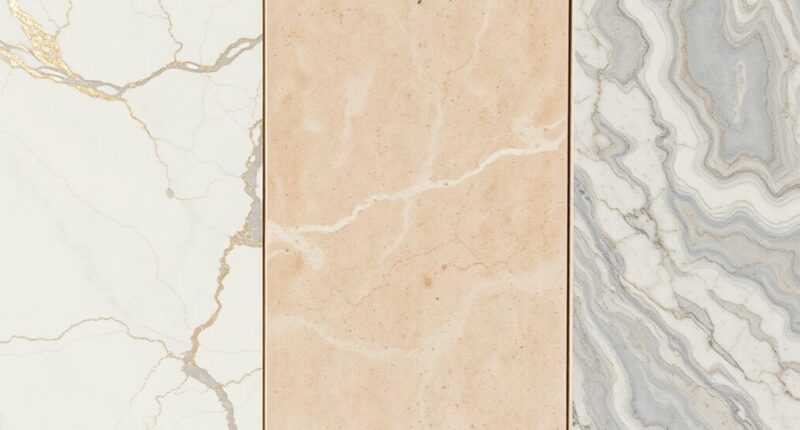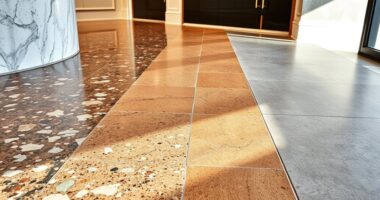Natural stone like marble, quartzite, and travertine offers timeless beauty, durability, and unique patterns that elevate any space. Marble’s striking veining and smooth surface bring elegance, while quartzite’s strength makes it perfect for high-traffic areas. Travertine adds warmth and rustic charm with its earthy textures. Each stone’s natural variations create a unique, authentic feel. To discover how these stones can transform your design, explore more about their characteristics and uses.
Key Takeaways
- Natural stone offers unique patterns and colors, enhancing aesthetic appeal in both traditional and modern design settings.
- Marble, quartzite, and travertine each provide distinctive textures and finishes, adding depth and character to interiors.
- These stones are versatile, suitable for flooring, countertops, backsplashes, and exterior applications, blending durability with beauty.
- Their natural origins reflect authenticity, supporting sustainable and eco-friendly design choices.
- Proper maintenance preserves their timeless elegance, ensuring long-lasting beauty and functionality in any space.
The Unique Characteristics of Marble
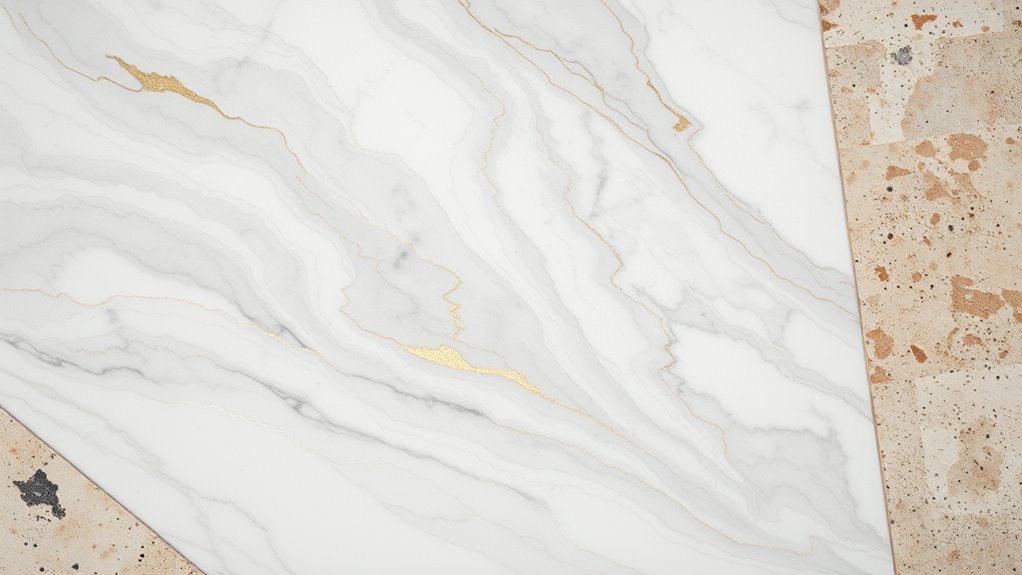
Marble stands out among natural stones because of its striking veining and smooth, polished surface. Its color variations range from pure whites and creamy beiges to deep greys, greens, and even pinks, giving you a versatile palette for any design. These hues and patterns are influenced by mineral deposits, making each piece unique. Additionally, marble’s authentic natural material contributes to its timeless appeal and ability to enhance both traditional and contemporary interiors. Its historical significance is evident in architectural marvels, reflecting a rich heritage that adds depth and character to your space. The stone’s enduring appeal isn’t just about looks; it reflects a timeless elegance that adds depth and character to your space. When you choose marble, you’re selecting a stone with a story, beauty, and timeless elegance that can elevate any interior or exterior project.
Exploring the Elegance of Quartzite
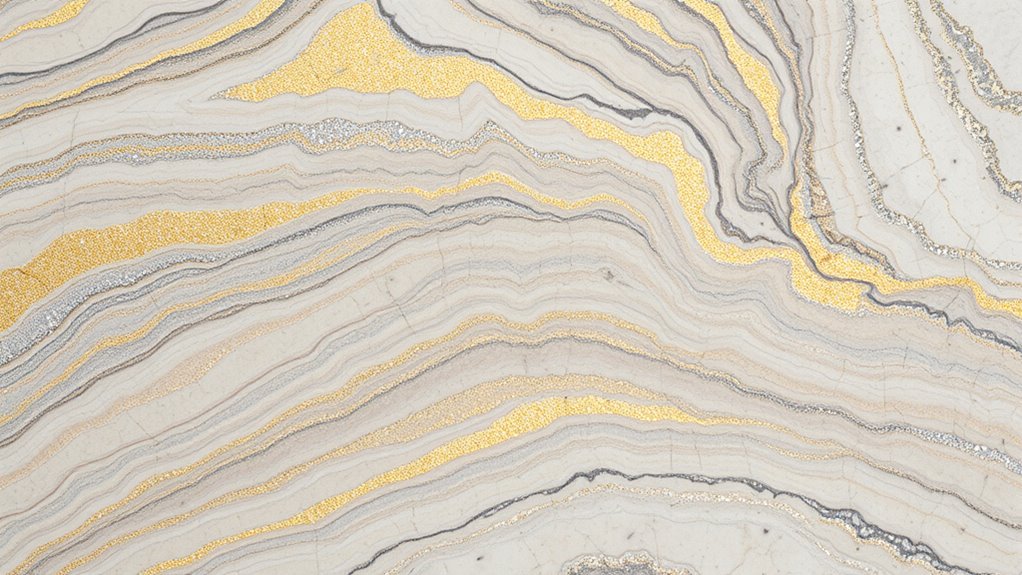
Have you ever admired the striking appearance of natural stone that combines both beauty and durability? Quartzite is a perfect example, blending stunning visual appeal with exceptional strength. Known for its high quartz content, this natural stone offers impressive durability, making it ideal for high-traffic areas like kitchen countertops and flooring. Its unique patterns and colors, often mimicking marble but with added resilience, continue to influence current natural stone trends. Quartzite resists scratching and staining better than many other options, giving you a long-lasting, elegant surface. When you choose quartzite, you’re opting for a sophisticated, durable material that elevates your design while keeping up with modern trends. Its timeless beauty and robustness make it a popular choice for those seeking both style and function, especially as natural stone options become more accessible and versatile. Additionally, the benefits of natural stone make it a valuable investment for any aesthetic or practical purpose in your home. For example, its resistance to heat and wear contributes to its longevity and suitability for everyday use. Moreover, considering its ability to enhance home value, quartzite is an excellent choice for sustainable and stylish interior upgrades.
The Warmth and Texture of Travertine
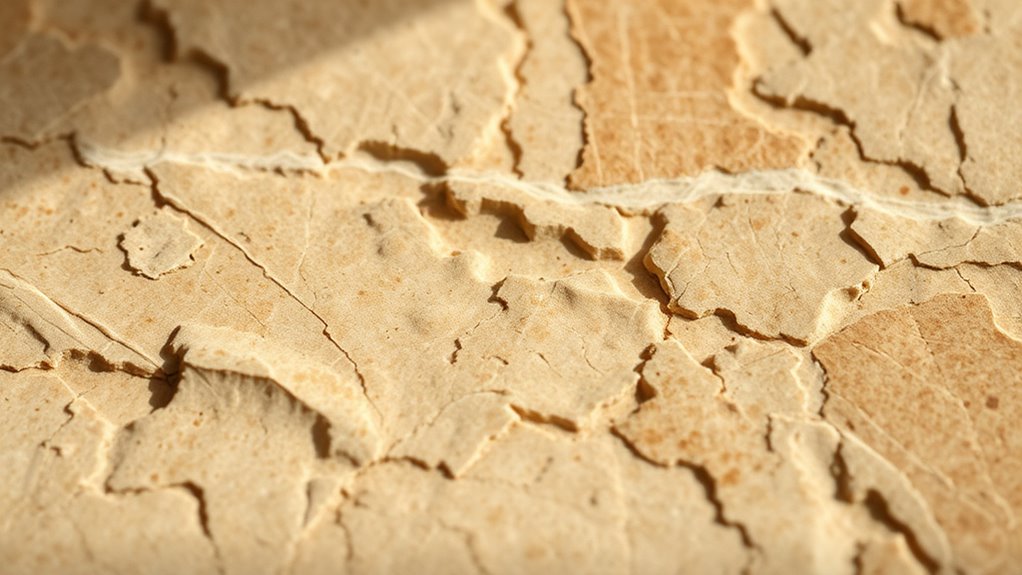
Travertine’s earthy color palette brings warmth and natural beauty to any space. Its unique surface patterns add texture and visual interest, making each piece one-of-a-kind. Additionally, understanding the tax implications of using natural stone in your home can help you make informed decisions about your project. You’ll find it versatile for various design uses, from flooring to accent walls, enhancing both style and comfort. Its natural origins and distinctive appearance can also contribute to a sustainable design approach, appealing to environmentally conscious homeowners. Incorporating organic materials like travertine aligns with eco-friendly practices and supports sustainable sourcing.
Earthy Color Palette
When you incorporate earthy tones into your design, you bring a sense of warmth and natural beauty that instantly grounds a space. These colors, like warm beiges and browns from travertine, connect to color psychology by promoting calmness and stability. Choosing natural stone with sustainable sourcing guarantees you support environmentally friendly practices while enhancing your environment’s authenticity. Earthy palettes also highlight textures, making surfaces feel inviting and tactile. To better understand this, consider the following:
| Color | Effect on Space | Connection to Natural Stone |
|---|---|---|
| Beige | Creates warmth | Common in travertine finishes |
| Taupe | Adds sophistication | Versatile, complements other stones |
| Warm Brown | Enhances coziness | Emphasizes natural textures |
| Soft Grey | Balances brightness | Highlights subtle mineral veins |
This palette emphasizes natural beauty and sustainable choices. Additionally, embracing attention in creative practice can help you appreciate and highlight the intricate textures present in natural stone surfaces.
Unique Surface Patterns
Natural stone surfaces like travertine showcase an array of unique patterns that add depth and character to any space. These patterns in geology result from mineral deposits and natural processes, making each piece one-of-a-kind. Surface patterns are formed through geological processes that create the diverse visual effects seen in travertine, emphasizing its natural origin. You’ll notice variations like swirling veils, honeycomb formations, and gentle pitting that create visual interest. Surface finish options, such as tumbled, honed, or brushed, further enhance these patterns, emphasizing the stone’s natural beauty and texture. The warm, earthy tones combined with these distinctive patterns make travertine perfect for adding character to your design. Whether used on floors, walls, or accents, the unique surface patterns highlight the stone’s natural origins and provide a timeless appeal that elevates any environment. Understanding surface patterns can help in selecting the right stone for your aesthetic preferences. Additionally, the sustainable qualities of natural stone make it a popular choice in eco-friendly design. Recognizing the geological formation process helps appreciate the diversity and authenticity of each piece. Incorporating mineral deposits into your design can further enhance the natural appeal of travertine and other stones.
Versatile Design Uses
Because of its warm tones and textured surface, travertine seamlessly enhances a variety of design styles, from rustic to modern. Its rich patterns and textures add visual interest, creating a cozy yet sophisticated atmosphere. Additionally, understanding the refrigeration cycle can inspire innovative ways to incorporate natural materials like travertine into energy-efficient and sustainable interiors. You can incorporate travertine in flooring, backsplashes, or accent walls, where its natural variation complements different patterns and design elements. When planning your space, focus on color coordination to balance its earthy hues with other materials and finishes. Its natural variations allow for unique and individualized designs that highlight the material’s authenticity. For example, material durability is a key consideration when selecting travertine for high-traffic areas. Incorporating proper sealing techniques can help maintain its beauty and longevity over time. Additionally, market demand for natural stone materials continues to grow, encouraging innovative applications in design. For a cohesive look, pair travertine with neutral tones or contrasting colors that highlight its warmth. Its versatility allows you to achieve both timeless elegance and contemporary flair, making it a perfect choice for a range of interior and exterior applications.
Designing With Natural Stone in Interior Spaces
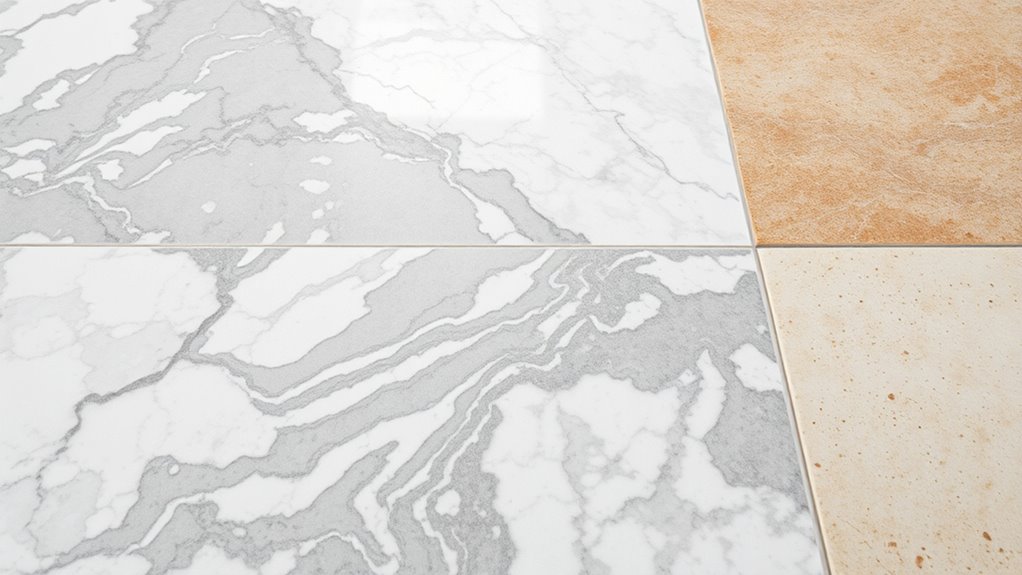
Incorporating natural stone into interior spaces can instantly elevate your design by adding texture, warmth, and a sense of timeless elegance. When choosing materials like marble, quartzite, or travertine, consider their historical significance and cultural symbolism. Vetted options ensure quality and durability, making your investment both beautiful and reliable. Additionally, understanding the durability of different stones can help you select the best material for high-traffic or moisture-prone areas.
For centuries, marble has represented luxury and status, while travertine’s roots trace back to ancient Rome, symbolizing durability and tradition. Using these stones thoughtfully can create a connection to history and culture, enriching your space’s story.
Whether you opt for a marble fireplace, a quartzite kitchen island, or travertine flooring, your choices reflect a respect for craftsmanship and heritage. This approach not only enhances aesthetic appeal but also imbues your interiors with a meaningful depth rooted in centuries of tradition.
Exterior Applications and Durability of Natural Stone
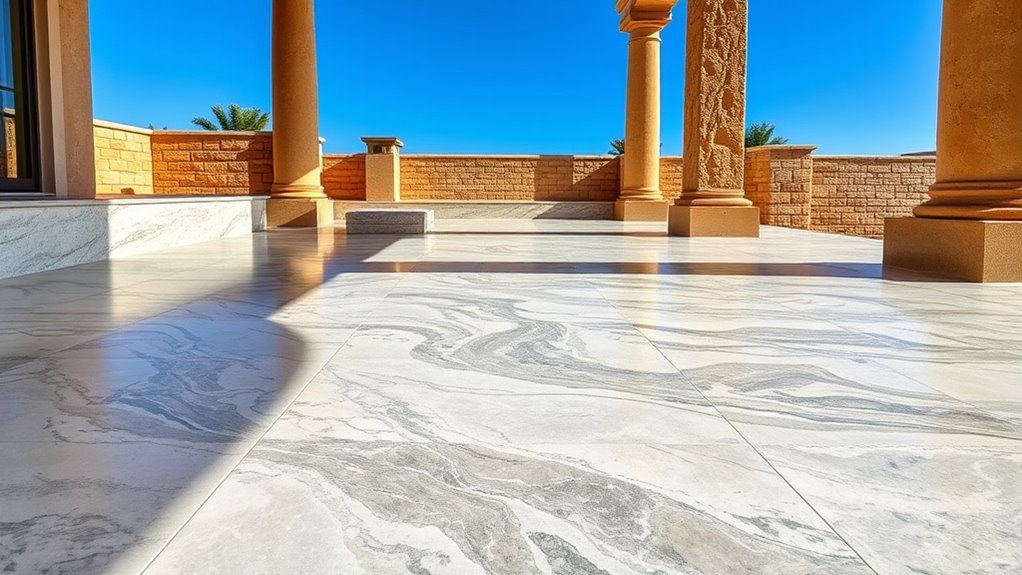
When choosing natural stone for outdoor use, you’ll want to consider its weather resistance and how it handles exposure to the elements.
Maintenance needs and how long it lasts are also key factors in ensuring your installation remains beautiful over time.
Additionally, proper installation is vital to maximize durability and performance in exterior applications.
Weather Resistance Qualities
Natural stone is renowned for its exceptional weather resistance, making it a reliable choice for exterior applications. Its inherent weather durability allows it to withstand rain, snow, and intense sunlight without deteriorating.
Many types, like quartzite and travertine, exhibit high climate adaptability, meaning they perform well in diverse environments, from humid coastal areas to cold, snowy regions. This resilience reduces concerns about cracking, spalling, or fading over time.
Properly selected and installed natural stone can maintain its beauty and structural integrity for decades, even when exposed to harsh weather conditions. By choosing the right type of stone for your climate, you ensure your exterior surfaces remain durable, attractive, and functional regardless of seasonal changes.
Maintenance and Longevity
Proper maintenance is essential to guarantee your natural stone surfaces remain durable and attractive over time. Regular sealing techniques help protect against stains and environmental damage, ensuring longevity. Apply sealers according to manufacturer instructions, especially for outdoor applications exposed to moisture and dirt.
Natural stones like marble, quartzite, and travertine have varying scratch resistance levels; understanding these differences helps you choose appropriate care methods. Use soft cloths and non-abrasive cleaners to prevent scratches, and avoid harsh chemicals that can weaken the stone’s surface.
Routine cleaning and proper sealing extend the life of your stone surfaces, keeping them looking pristine for years. With consistent upkeep, your natural stone will maintain its beauty and durability, even in demanding exterior environments.
Installation Considerations
Choosing the right installation method is essential for ensuring the durability of natural stone in exterior applications. Proper installation techniques prevent issues like cracking, shifting, or staining. Use appropriate adhesives and supports suited for outdoor conditions. Sealing and protection are crucial; apply a high-quality sealant to guard against moisture, dirt, and temperature changes. Consider climate factors that may affect stone performance and select materials accordingly. Regular maintenance, including resealing, extends the stone’s lifespan.
| Installation Techniques | Sealing & Protection |
|---|---|
| Proper substrate prep | Sealant application frequency |
| Correct adhesive use | Weather-resistant coatings |
| Leveling for stability | Reapplication schedule |
| Expansion joints | Protective finishes |
Maintenance and Care for Marble, Quartzite, and Travertine
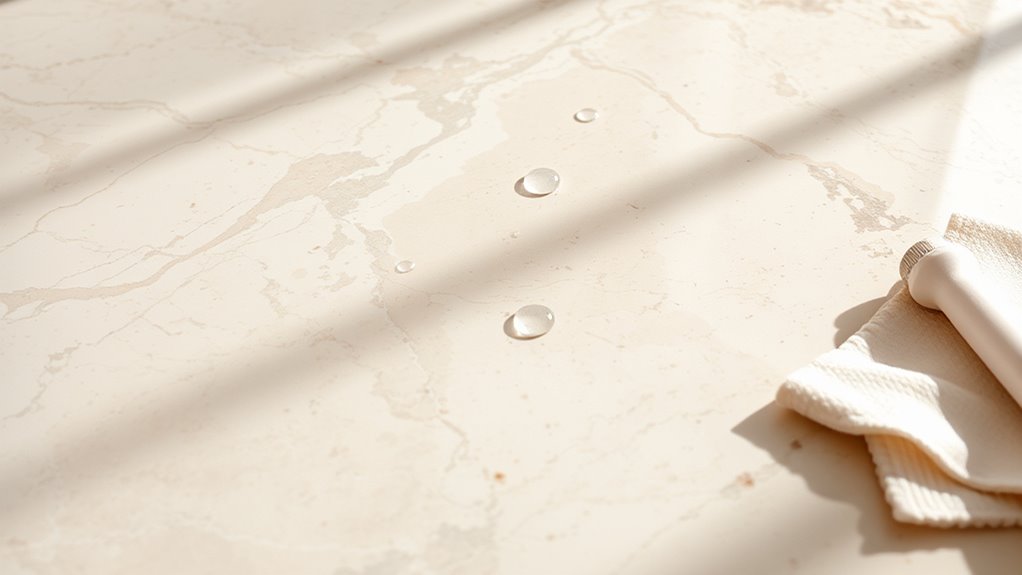
Maintaining marble, quartzite, and travertine requires regular attention to keep them looking their best. Start by applying proper sealing techniques to protect the surfaces from stains and moisture. Sealing should be done periodically, depending on the stone type and usage, to maintain durability.
Establish consistent cleaning routines using gentle, pH-neutral cleaners designed for natural stone; avoid acidic or abrasive products that can damage the surface. Wipe up spills immediately to prevent staining, especially on marble and travertine, which are more porous.
Regularly dust or sweep to prevent dirt buildup, and use soft cloths or mops for cleaning. Proper maintenance prolongs the beauty of your stone surfaces and keeps them looking pristine for years to come.
Tips for Choosing the Right Stone for Your Project
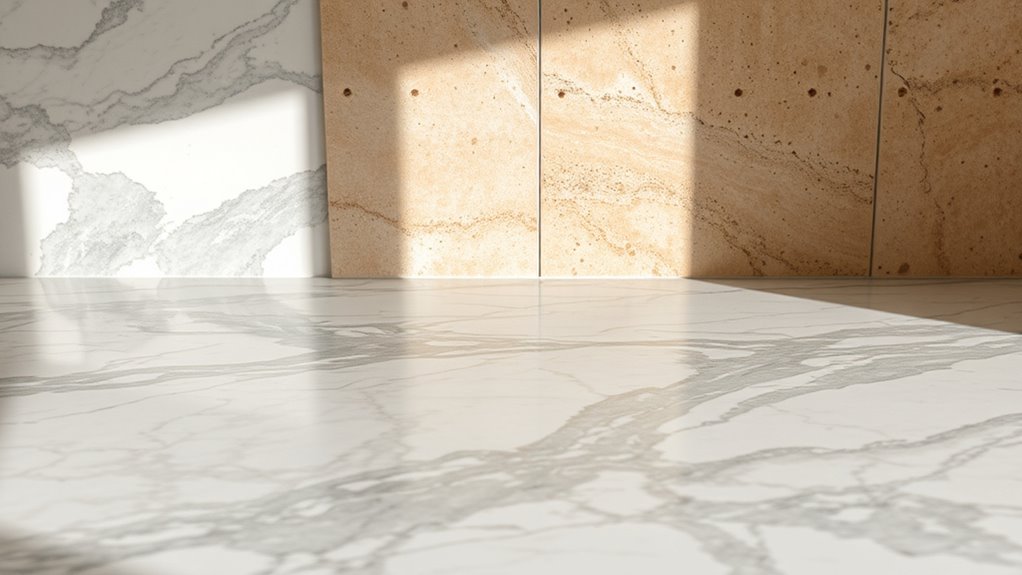
Selecting the right stone for your project involves considering both aesthetic preferences and practical needs. Start by evaluating your style and the overall look you want to achieve.
Next, think about stone sourcing—choose suppliers committed to sustainable practices to minimize environmental impact.
Durability is vital; for high-traffic areas, opt for harder stones like quartzite or granite.
Consider maintenance requirements—some stones need more care than others.
Also, inspect the stone’s origin to guarantee quality and ethical sourcing.
Keep in mind your budget, as sourcing from local or responsibly managed quarries can reduce costs and support sustainability.
Frequently Asked Questions
How Do Natural Stones Impact Indoor Air Quality?
Natural stones can positively impact your indoor air quality because they don’t emit volatile organic compounds (VOCs), unlike many synthetic materials. When you choose natural stone for surfaces, you reduce the presence of harmful chemicals in your home, creating a healthier environment.
Plus, proper sealing and maintenance help prevent dust and allergens from settling, further improving indoor air quality. So, natural stones not only look beautiful but also support a cleaner, safer indoor space.
Are There Eco-Friendly Options for Sourcing Natural Stone?
Did you know that around 40% of natural stone suppliers now prioritize eco-conscious sourcing? When you seek natural stone, look for options with sustainable quarrying practices, which minimize environmental impact.
This approach supports eco-friendly sourcing, ensuring the stones you choose are responsibly sourced. By choosing these options, you help reduce the carbon footprint associated with extraction, making your design both beautiful and environmentally conscious.
Can Natural Stone Be Recycled or Repurposed?
You can definitely recycle or repurpose natural stone using various recycling processes and repurposing techniques. By carefully removing and cleaning the stone, you can reuse it for new projects such as countertops, tiles, or decorative features.
Many facilities specialize in breaking down and refurbishing stone, making it eco-friendly. So, instead of discarding, you can give natural stone a second life, reducing waste and supporting sustainable design practices.
What Are the Latest Trends in Natural Stone Design?
Imagine your space as a living canvas, where natural stone tells its story. The latest trends highlight sleek, minimalist designs with bold veining and earthy tones.
You’ll love how marble upkeep has become easier with modern sealants, while quartzite durability guarantees your statement piece withstands time’s test.
Embrace these trends to create a sophisticated, timeless look that captures nature’s artistry and your unique style effortlessly.
How Does Natural Stone Influence Property Value?
Natural stone considerably boosts your property’s value by adding luxury appeal and showcasing timeless durability. When you incorporate materials like marble, quartzite, or travertine, you create a sophisticated look that attracts buyers and increases your home’s worth.
Its high-quality, durable nature ensures long-lasting beauty and functionality. By choosing natural stone, you elevate your property’s marketability, making it a smart investment that reflects elegance and resilience for years to come.
Conclusion
Embracing natural stone like marble, quartzite, and travertine brings timeless beauty to your space—much like a classic masterpiece hanging in the Louvre. With their unique characteristics and durability, you can craft interiors and exteriors that stand the test of time. Just remember, a little TLC keeps your stone looking majestic. So, choose wisely and let your project become a legend in its own right—no need to wait for a knight in shining armor to appreciate its charm.
